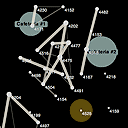25C3 - 1.4.2.3
25th Chaos Communication Congress
Nothing to hide
| Referenten | |
|---|---|
|
|
Ciro Cattuto |
|
|
Milosch Meriac |
|
|
aestetix |
| Programm | |
|---|---|
| Tag | Day 4 (2008-12-30) |
| Raum | Saal 2 |
| Beginn | 15:15 |
| Dauer | 01:00 |
| Info | |
| ID | 2899 |
| Veranstaltungstyp | lecture |
| Track | Hacking |
| Sprache der Veranstaltung | en |
| Feedback | |
|---|---|
|
Haben Sie diese Veranstaltung besucht? Feedback abgeben |
Mining social contacts with active RFID

We describe the implementation of a distributed proximity detection firmware for the OpenBeacon RFID platform. We report on experiments performed during conference gatherings, where the new feature of proximity detection was used to mine and expose patterns of social contact. We discuss some properties of the networks of social contact, and show how these networks can be analyzed, visualized, and used to infer the underlying social structure.
The SocioPatterns project aims to shed light on patterns and statistical regularities in social dynamics. To date, little quantitative information is available about these patterns, and measuring real-world dynamics is indispensable for obtaining a complete picture. In this talk we focus on social contact between people and describe how the OpenBeacon active RFID platform was used to gather experimental data on social contact at a few conference gatherings.
In a variety of contexts, spatial proximity is a good proxy for social interaction. Spatial proximity of persons wearing active RFID tags can be inferred by tracking the location of the tags, and using the position information to decide whether two tags are located nearby. However, locating the tags requires several receiving stations, and contact inference is subjected to errors that limit both its spatial and temporal accuracy. Because of this, we decided to move from contact inference to direct contact detection.
We rewrote the firmware of the OpenBeacon tags specifically targeting proximity detection. We are now able to detect proximity between persons with a very good spatial (~1 m) and temporal (~10 s) resolution. We achieve this by operating the RFID devices in a bi-directional fashion, over multiple radio channels. Tags no longer act as simple beacons, emitting signals for the receiving infrastructure. They exchange messages in a peer-to-peer fashion, to sense their neighborhood and assess contact with other tags. The contact events detected by the RFID network are then relayed to the monitoring infrastructure and post-processed. On suitably tuning the system parameters we achieve reliable detection of face-to-face interaction within about 1 m. This allows, for example, to discriminate who is talking with whom in a small crowded room.
In this talk we discuss our implementation of the contact detection firmware for OpenBeacon tags. We provide some details on data analysis and on the visualization of the longitudinal contact networks we measure. We report the results of an experiment involving about 100 people at a conference, and discuss some interesting statistical regularities of social contact. We also discuss how contact information and trajectory similarity can be used to infer the structure of the social network underlying the community of monitored persons, and how background information can be integrated into this picture. We close by pointing to future directions for research as well as to mashups with social networking services.
